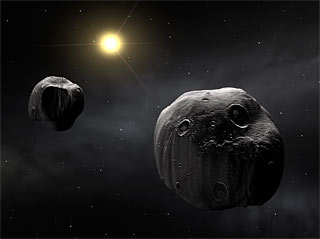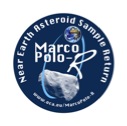NEAs are among the most accessible bodies of the Solar System. Many of them have flexible launch windows and short mission durations (e.g. less than 10 years for a sample return).
Physical properties of the baseline target of the MarcoPolo-R Mission:
the PotentiallyHazardous Asteroid (341843) 2008 EV5
The baseline target of the ESA-led scheme of MarcoPolo-R is asteroid 2008 EV5. This target allows a cost reduction of the current mission and a shorter mission duration (round-trip time 4.5 years). Moreover, new observational data for this target, which had not been available at the time of writing of the proposal and the first study phases, show that 2008 EV5 has an outstanding interest for the key science related to surface sampling from a primitive asteroid and sample return to Earth. It shows a spectrum indicating a primitive asteroid, a spectral signature at 0.48 um and an albedo of 10 - 12 %, which is higher than that of targets of the other sample return missions to be launched (e.g. Hayabusa 2/JAXA, OSIRIS-REx/NASA). Radar observations of the object are available, giving a size of about 0.4 km. The spectral feature indicates probable alteration by water, and therefore it is likely that this body is particularly primitive in nature, having accreted in a volatile-rich region. The spectrum compares well with CI meteorites, also known as very primitive objects. The reduced mission duration will bring the time of the sample analysis closer to the expected return times of other sample return missions, allowing Europe to contribute in a timely manner to the international sample return activities. Radar Observations of 2008 EV5 (shape model and radar signal); from Busch et al. 2011. Icarus 212, 649-660
Radar Observations of 2008 EV5 (shape model and radar signal); from Busch et al. 2011. Icarus 212, 649-660
Mission profiles have been defined every year between 2022 and 2024. They all use only one Earth fly-by and the fully recurring electric propulsion engines of Smart-1, direct escape and a Soyuz Fregat launch vehicle. A touch and go sampling operation has been selected, making the touchdown and GNC system design relatively simple. In addition, a fully passive re-entry capsule is considered with no parachutes and no beacons.
Overall, the new target leads to a large simplification of the mission design (shorter mission, lower cost propulsion system directly re-used from Smart-1, very simple communication system, lower power need, much less challenging thermal design, less risk due to the absence of a secondary body, lower re-entry velocity, etc.). Because of its observed characteristics, this target offers both unique science and minimum cost mission design.
For historical reason we indicate below the target that was originally chosen as baseline, before 2008 EV5 data were made available, demonstrating its unique science value.
- (175706) 1996FG3: binary NEA
Primary taxonomic type: C
Primary geometric albedo: 0.035

Primary diameter: 1.9 km
Primary spin period: 3.5942 h
Primary density: 0.9 g/cc
Secondary diameter: 0.43 km
Secondary to primary diameter ratio: 0.31
Secondary orbital semimajor axis: 2.4 km
Secondary orbital eccentricity: 0.05
Secondary orbital period around primary: 16.135 h
